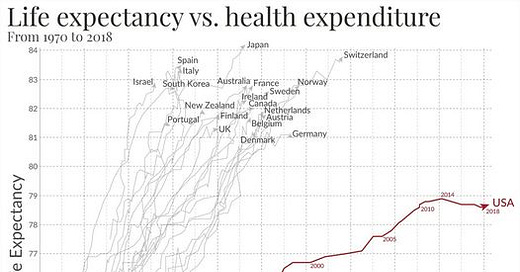Are We Really Living Longer?
A Criticial Examination of Whether Our Life Expectancy Has Increased Since the 1800s and at What Cost?
One of the most common claims in modern healthcare is that we are living longer than ever before. This assertion is often cited by the media, health professionals, and government officials to justify advancements in medical technology, research, and spending. However, when we dig deeper into the reality behind this statement, the truth is far more nuanced. While life expectancy has increased slightly in recent decades, this comes at a significant cost—both to our quality of life and the sustainability of our healthcare systems.
Life Expectancy: A Closer Look at the Numbers
At first glance, it seems we are enjoying longer lives compared to previous generations. Statistics credit modern medical advancements—including treatments for infectious diseases, surgical innovations, and pharmaceuticals—for extending our lifespans. However, a deeper examination reveals a more complex story. If we strip away the drastic reductions in mortality from factors like high infant mortality rates and infectious diseases that once claimed millions of lives, the actual increase in average life expectancy is modest—perhaps only two to three years longer than our ancestors from the 1800s.
While even a small increase in lifespan might seem like progress, it’s essential to ask: at what cost? Medical advancements have undoubtedly helped us survive immediate threats, but they haven’t necessarily translated into healthier, more fulfilling lives in our later years.
Vitality in the 1800s: A Different Kind of Longevity
Our ancestors of the 1800s not only lived long lives but often maintained vitality until the day they died. While average life expectancy during that era was lower due to high infant mortality rates and a lack of treatments for acute infections, those who survived into adulthood frequently enjoyed robust health into old age. They lived in alignment with natural rhythms, consuming whole, nutrient-dense foods, engaging in regular physical activity through manual labor, and spending much of their time outdoors.
Unlike modern times, where chronic diseases dominate the later years, many of our ancestors lived free of these long-term, debilitating conditions. Their diets were rich in local, seasonal, unprocessed foods, and they were not subjected to the pervasive artificial light and sedentary lifestyles that characterize contemporary living. These factors allowed them to sustain physical and mental vigor throughout life, with death often occurring suddenly rather than after prolonged illness.
The Hidden Cost: Chronic Disease and Declining Quality of Life
The claim that we’re living longer often overlooks the prevalence of chronic diseases, which have become a defining feature of modern aging. Although we may be surviving slightly longer, the quality of our extended years is frequently compromised by conditions such as heart disease, diabetes, cancer, and neurodegenerative disorders. In fact, approximately 80% of people today are expected to die from chronic illnesses.
These conditions typically emerge in the latter stages of life and demand ongoing medical treatments, medications, and interventions. As a result, many individuals spend their final years grappling with diminished physical and mental health, a loss of independence, and mounting medical expenses. While we may have added a few years to our lives, those years are often burdened with suffering and dependency, rather than vitality and joy.
The Financial Toll: Are We Spending Wisely?
Another critical aspect to consider is the financial burden of extending life expectancy. Governments, healthcare systems, and individuals collectively spend billions—if not trillions—of dollars annually on medical interventions designed to prolong life. However, the returns on this investment are frequently underwhelming.
The majority of healthcare spending is directed toward managing chronic illnesses, which often have little chance of resolution through conventional medical approaches. This means we’re allocating enormous resources to prolong lives by a few years, often in poor health, rather than investing in preventive measures and lifestyle changes that could enhance both the length and quality of life.
A Call for Re-evaluation: Shifting the Focus
It’s time to reconsider the popular narrative that we are living longer and examine the bigger picture. Are these additional years spent in good health, enjoying life, and contributing meaningfully to society? Or are they simply extra years spent managing chronic diseases and enduring medical treatments?
If we genuinely want to improve life expectancy in a meaningful way, we need to shift our focus from reactive medicine to proactive wellness. This means prioritizing:
Nutrient-dense diets: Consuming whole, local, seasonal, unprocessed foods that nourish the body and mind.
Regular physical activity: Engaging in natural, gentle movement.
Outdoor exposure: Maximizing time spent outdoors to benefit from sunlight, fresh air, and natural rhythms.
Circadian alignment: Reducing exposure to artificial light, especially in the evening, and optimizing sleep quality.
These simple yet profound lifestyle adjustments can have a far greater impact on long-term health and vitality than the current interventions offered by centralized medicine.
Conclusion
The idea that we are living longer is only part of the story. While medical advancements have helped us survive immediate threats, they have not necessarily contributed to healthier, more fulfilling lives. Chronic disease, declining quality of life, and unsustainable healthcare costs challenge the notion that we’re truly better off.
By shifting our priorities toward prevention, wellness, and lifestyle optimization, we can create a future where longevity is not merely about adding years to life but adding life to years. It’s time to question the status quo and embrace a more holistic approach to health and aging.
For those who want more in-depth guidance, please contact me about 1-1 consultations. In addition, I invite you to join my paid membership community, The Sleep Better Forum. Together, we’ll explore the science behind circadian principles, dive into supplement use, and learn how to optimize sleep for lasting health. You can find more information either here or on my website at www.pamkilleen.com.




